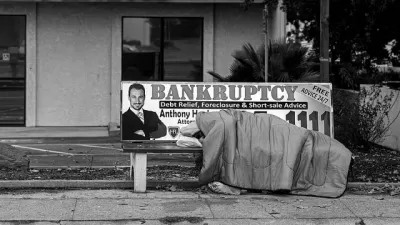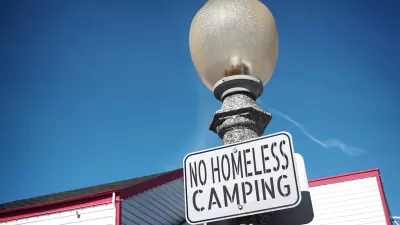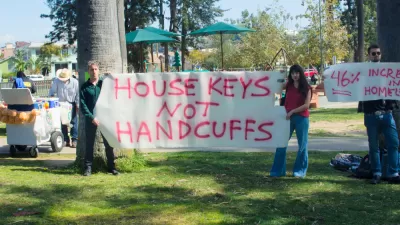The Title V program makes the hard parts of solving homelessness—finding the money and the property—a lot easier. So why hasn't it been used at a much larger scale?

Kriston Capps provides an explainer of a little-known provision of federal law that could provide large-scale benefit in finding shelter for the homeless population living in this country. The name of the government program is Title V, and it was enacted by the McKinney-Vento Homeless Assistance Act of 1987, which Capps describes as the most ambitious federal law that Congress has ever passed on homelessness.
Title V—that’s the name of the 1987 provision that transfers disused federal properties to homeless-service providers—addresses one of the most vexing questions dogging many American cities. There’s vacant property everywhere, and there are homeless people everywhere. So why the hell don’t we use that property to house the homeless?
Despite bureaucratic obstacles, detailed by Capps in the article, Title V "has created some 500 emergency shelters, transitional housing facilities, nonprofit offices, and other spaces using about 900 acres of federal land across 30 states and D.C."
But a new federal law, approved late last year called the Federal Assets Sale and Transfer Act of 2016, could help remove some of those obstacles and unleash the full potential of Title V. Capps explains the changes to the program enacted last year:
The FAST Act included big changes for Title V. It enabled HUD to list properties online, through the HUD Exchange. (According to Juanita Perry, HUD’s Title V lead, the department is currently working on a mapping tool to make these opportunities even more visible.) The formal application process with HHS was broken into two steps, giving nonprofits four months to demonstrate financing options. The bill streamlined certain other eligibility criteria, too. And under FAST, properties could be used for permanent supportive housing, not just shelters, a major expansion to the scope of potential programming.
In shedding light on the Title V program, Capps also implies an appeal to all levels of government to get to work on solving homelessness, and offers Title V as an example of powerful tools that already exist for addressing some of the country's biggest challenges.
FULL STORY: The Unsung Government Program That Gives Federal Property to the Homeless

Trump Administration Could Effectively End Housing Voucher Program
Federal officials are eyeing major cuts to the Section 8 program that helps millions of low-income households pay rent.

Planetizen Federal Action Tracker
A weekly monitor of how Trump’s orders and actions are impacting planners and planning in America.

Ken Jennings Launches Transit Web Series
The Jeopardy champ wants you to ride public transit.

New Jersey Lawsuit Targets Rent-Setting Algorithms
The state of New Jersey is taking legal action against landlords and companies that engage in what the state’s Attorney General alleges is illegal rent fixing.

Washington Legislature Passes Rent Increase Cap
A bill that caps rent increases at 7 percent plus inflation is headed to the governor’s desk.

From Planning to Action: How LA County Is Rethinking Climate Resilience
Chief Sustainability Officer Rita Kampalath outlines the County’s shift from planning to implementation in its climate resilience efforts, emphasizing cross-departmental coordination, updated recovery strategies, and the need for flexible funding.
Urban Design for Planners 1: Software Tools
This six-course series explores essential urban design concepts using open source software and equips planners with the tools they need to participate fully in the urban design process.
Planning for Universal Design
Learn the tools for implementing Universal Design in planning regulations.
Heyer Gruel & Associates PA
Ada County Highway District
Institute for Housing and Urban Development Studies (IHS)
City of Grandview
Harvard GSD Executive Education
Toledo-Lucas County Plan Commissions
Salt Lake City
NYU Wagner Graduate School of Public Service





























